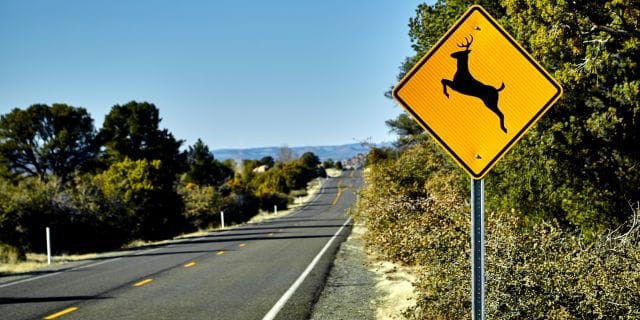It’s a moment every driver dreads: the sudden thud, the jolt of your car, and the sinking realization that you’ve hit an animal. Your heart races, and questions flood your mind—what should you do next? Knowing how to respond calmly and responsibly in this situation can make all the difference. Let’s break down the steps to take if you find yourself in this unfortunate situation.
Honk and brake.
You see a deer—or a raccoon, coyote or other animal. Your first instinct might be to swerve. Think twice, as it could put you directly into oncoming traffic or cause you to crash into the trees. The best thing to do is sound your horn and hit your brakes. The hope is the animal will be startled and run, or that you’ll slow down enough to lessen the impact. The only time you should swerve is for animals, like moose, that weigh 1,000 lbs. or more.
Pull over to the side of the road.
Hitting an animal can be nerve-wracking. Do your best to remain calm. You’ll want to pull over safely to the side of the road as soon as possible. Turn on your hazard lights. Put up flares if you have them so you’re visible to other drivers. If it’s dark and the animal is lying on the road, you can point your headlights toward it, so the animal is visible to other motorists.
Check yourself and your passengers for injuries.
You just experienced a collision. Check yourself and your passengers for injuries, and if anyone needs immediate medical attention, call 9-1-1. Otherwise, attend to any pressing injuries using your first aid kit.
Call the police.
Report the accident to the police. (In some areas, there are fines for not reporting collisions with animals who are 55 lbs. or more.) You will want to let them know if the animal is obstructing the road and is a danger to other drivers. The police will file a report which you can use when you submit an insurance claim.
When it’s safe, get out of your vehicle.
The only times you shouldn’t exit your vehicle is if you hit a predatory animal like a mountain lion or bear, or if conditions outside are dangerous. When you feel comfortable, get out of your car and survey the scene. Carry a light so that any approaching vehicles will be able to see you.
Do not approach the animal.
Take stock of the animal from a safe distance but do not approach. If the animal is hurt, it could be afraid, dangerous and unpredictable. Do not try to move the animal; wait for police or wildlife control assistance. If you hit a farm animal or a family pet, there may be a tag or other identification. This will allow you to contact the owner. Owners of farm animals that are not correctly corralled could be charged with negligence and could be required to pay for your damages.
Take photos of any damage.
Collisions with animals could cause significant damage to your vehicle, including dents you can see and issues you cannot. Take pictures of any damage to your car’s body or bumper. Also take photos of the area around the accident. Make notes about what happened, including road conditions, exact location, date, time, and any other details that tell the story.
Contact your insurance company.
If your car is damaged, you may want to file a claim with your insurance company. You will need comprehensive coverage for collisions with animals. This is an optional addition to your standard vehicle insurance policy. If you don’t have this coverage, you may want to consider adding it.
Take your car to a reputable auto body shop.
You had an accident, and you want to make sure there’s no damage below the surface that you cannot see. If you have a diagnostic scan tool, you can use it to pinpoint issues and know whether your car is safe to drive. You will want to get your car checked out with your trusted mechanic to make sure everything is still working well.
Reduce Your Risk of Hitting an Animal.
You can take steps to reduce your risk of hitting an animal in the future. Follow these guidelines.
- Animals are more active at dusk and dawn. Be alert during these hours.
- Pay attention to animal crossing signs. These are areas where animals are likely to be.
- Look for movement along the side of the road. That could indicate an animal nearby.
- Be careful when roads are slippery, and visibility is reduced.
- Use your brights to see farther at a distance, if other cars are not coming the opposite direction.
- Ask your passengers to watch out for animals too. Another set of eyes is always helpful.
- Avoid distractions that could take your attention away from the road.
Finally, make sure your vehicle is protected with the right insurance. This will help your peace of mind should you get into an accident. Safe travels.
This article is furnished by California Casualty, providing auto and home insurance to educators, law enforcement officers, firefighters, and nurses. Get a quote at 1.866.704.8614 or www.calcas.com.
- Tires 101: Rotation, Alignment and Balancing Explained - December 22, 2025
- Holiday Fire Safety Tips - December 16, 2025
- Party Potluck Recipes - December 11, 2025

